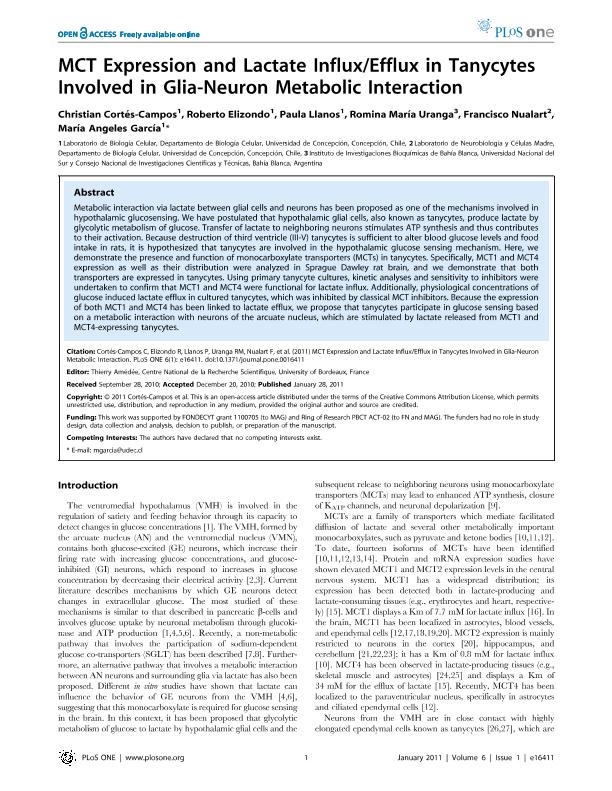Mostrar el registro sencillo del ítem
dc.contributor.author
Cortés Campos, Christian
dc.contributor.author
Elizondo, Roberto
dc.contributor.author
Llanos, Paula
dc.contributor.author
Uranga, Romina Maria

dc.contributor.author
Nualart, Francisco
dc.contributor.author
García, María de Los Ángeles
dc.date.available
2016-10-26T18:45:06Z
dc.date.issued
2011-01-28
dc.identifier.citation
Cortés Campos, Christian; Elizondo, Roberto; Llanos, Paula; Uranga, Romina Maria; Nualart, Francisco; et al.; MCT expression and lactate influx/efflux in tanycytes involved in glia-neuron metabolic interaction; Public Library Of Science; Plos One; 6; 1; 28-1-2011; e16411
dc.identifier.issn
1932-6203
dc.identifier.uri
http://hdl.handle.net/11336/7805
dc.description.abstract
Metabolic interaction via lactate between glial cells and neurons has been proposed as one of the mechanisms involved in hypothalamic glucosensing. We have postulated that hypothalamic glial cells, also known as tanycytes, produce lactate by glycolytic metabolism of glucose. Transfer of lactate to neighboring neurons stimulates ATP synthesis and thus contributes to their activation. Because destruction of third ventricle (III-V) tanycytes is sufficient to alter blood glucose levels and food intake in rats, it is hypothesized that tanycytes are involved in the hypothalamic glucose sensing mechanism. Here, we demonstrate the presence and function of monocarboxylate transporters (MCTs) in tanycytes. Specifically, MCT1 and MCT4 expression as well as their distribution were analyzed in Sprague Dawley rat brain, and we demonstrate that both transporters are expressed in tanycytes. Using primary tanycyte cultures, kinetic analyses and sensitivity to inhibitors were undertaken to confirm that MCT1 and MCT4 were functional for lactate influx. Additionally, physiological concentrations of glucose induced lactate efflux in cultured tanycytes, which was inhibited by classical MCT inhibitors. Because the expression of both MCT1 and MCT4 has been linked to lactate efflux, we propose that tanycytes participate in glucose sensing based on a metabolic interaction with neurons of the arcuate nucleus, which are stimulated by lactate released from MCT1 and MCT4-expressing tanycytes.
dc.format
application/pdf
dc.language.iso
eng
dc.publisher
Public Library Of Science

dc.rights
info:eu-repo/semantics/openAccess
dc.rights.uri
https://creativecommons.org/licenses/by/2.5/ar/
dc.subject
Glucosensing
dc.subject
Tanycytes
dc.subject
Monocarboxylate Transporters
dc.subject
Lactate
dc.subject.classification
Bioquímica y Biología Molecular

dc.subject.classification
Ciencias Biológicas

dc.subject.classification
CIENCIAS NATURALES Y EXACTAS

dc.title
MCT expression and lactate influx/efflux in tanycytes involved in glia-neuron metabolic interaction
dc.type
info:eu-repo/semantics/article
dc.type
info:ar-repo/semantics/artículo
dc.type
info:eu-repo/semantics/publishedVersion
dc.date.updated
2016-07-05T18:48:11Z
dc.journal.volume
6
dc.journal.number
1
dc.journal.pagination
e16411
dc.journal.pais
Estados Unidos

dc.journal.ciudad
San Francisco
dc.description.fil
Fil: Cortés Campos, Christian. Universidad de Concepción. Departamento de Biología Celular; Chile
dc.description.fil
Fil: Elizondo, Roberto. Universidad de Concepción. Departamento de Biología Celular; Chile
dc.description.fil
Fil: Llanos, Paula. Universidad de Concepción. Departamento de Biología Celular; Chile
dc.description.fil
Fil: Uranga, Romina Maria. Consejo Nacional de Investigaciones Cientificas y Técnicas. Centro Científico Tecnológico Bahia Blanca. Instituto de Investigaciones Bioquímicas Bahia Blanca (i); Argentina. Universidad Nacional del Sur; Argentina
dc.description.fil
Fil: Nualart, Francisco. Universidad de Concepción. Departamento de Biología Celular; Chile
dc.description.fil
Fil: García, María de Los Ángeles. Universidad de Concepción. Departamento de Biología Celular; Chile
dc.journal.title
Plos One

dc.relation.alternativeid
info:eu-repo/semantics/altIdentifier/doi/http://dx.doi.org/10.1371/journal.pone.0016411
dc.relation.alternativeid
info:eu-repo/semantics/altIdentifier/url/https://www.ncbi.nlm.nih.gov/pmc/articles/PMC3030577/
dc.relation.alternativeid
info:eu-repo/semantics/altIdentifier/url/http://journals.plos.org/plosone/article?id=10.1371/journal.pone.0016411
Archivos asociados
